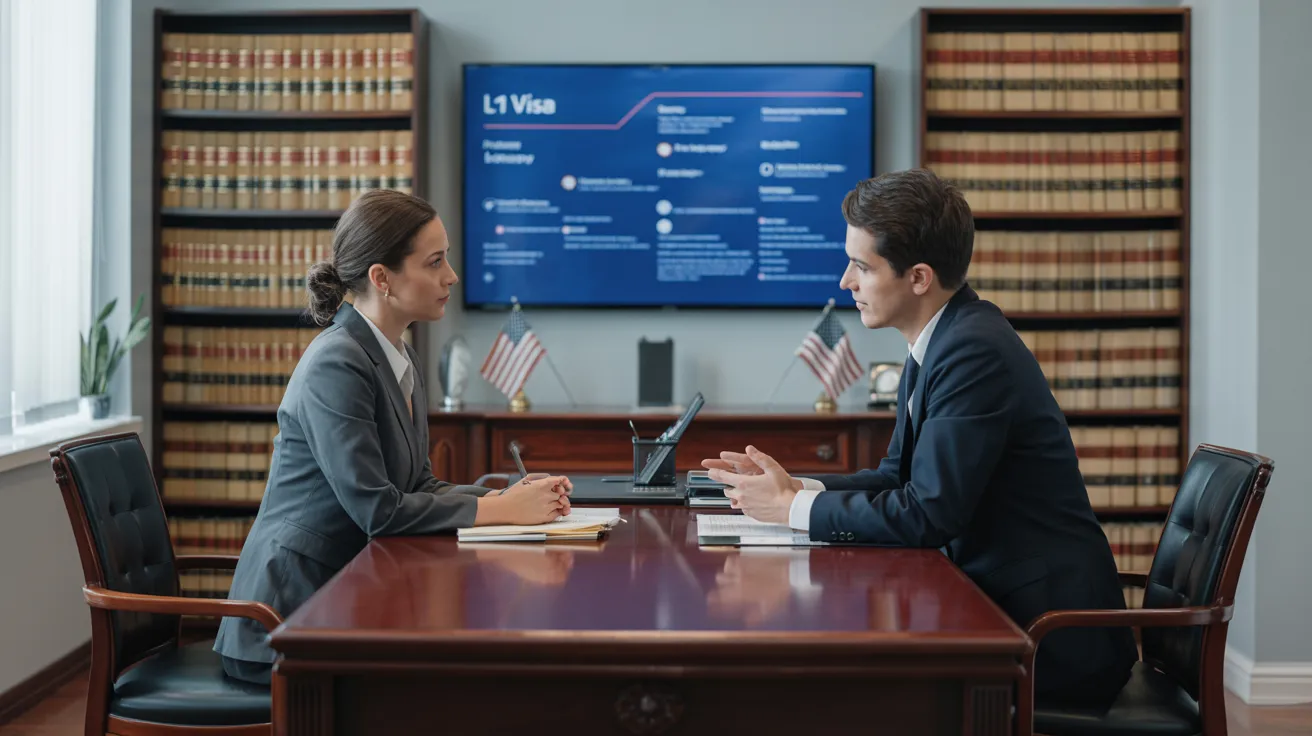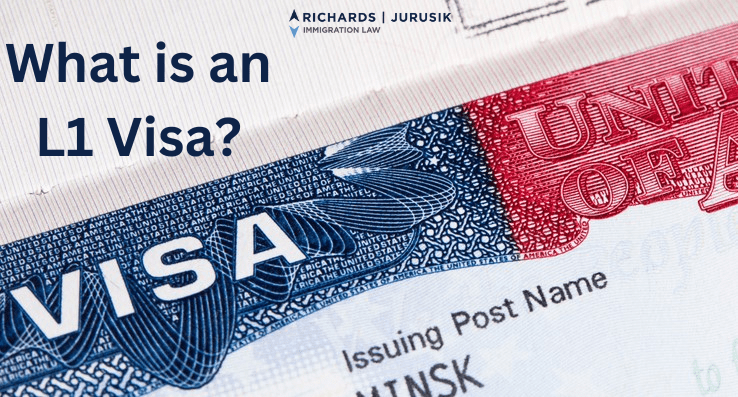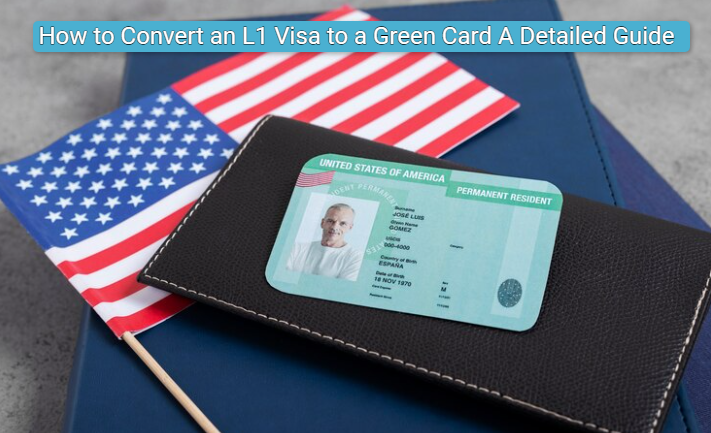Opening Opportunities: A Comprehensive Overview to the L1 Visa Process
The L1 visa process provides a vital pathway for international firms looking for to move essential employees throughout boundaries. Comprehending the nuances of qualification standards, the distinctions between L-1A and L-1B visas, and the details of the application process can significantly affect an applicant's success. Steering this facility landscape is not without its obstacles, and mindful focus to documents and company sponsorship is vital. As we check out the vital components of this process, the techniques for conquering potential obstacles will certainly become obvious, disclosing exactly how informed preparation can open up a globe of opportunities.
Understanding the L1 Visa
Recognizing the L1 visa involves acknowledging its importance as a crucial device for international firms looking for to transfer knowledgeable staff members between global workplaces. This non-immigrant visa classification assists in the activity of executives, supervisors, and specialized knowledge workers to the USA, thus making it possible for organizations to preserve operational connection and harness international skill efficiently. The L1 visa is split into two key classifications: L-1A for supervisors and executives, and L-1B for workers possessing specialized knowledge.The L1 visa offers an essential role in improving a firm's competitive side in the worldwide industry. By enabling business to move their vital workers, organizations can ensure that critical projects are handled by qualified individuals that are already accustomed to the company's culture and operational processes. L1 Visa Lawyer. This inner transfer device not just fosters expertise sharing however likewise advertises development and cooperation across borders.Moreover, the L1 visa is typically favored for its relatively straightforward application process compared to various other visa classifications, as it allows for dual intent, allowing owners to go after irreversible residency while on a momentary job visa. This function makes the L1 visa especially appealing for both employers and workers, as it improves the pathway for knowledgeable specialists to establish lasting residency in the United States
Qualification Standards
Qualification for the L1 visa rests on several vital standards that assure both the employee and the employer meet certain credentials. This non-immigrant visa is developed for multinational firms to transfer employees from consular services to united state counterparts.Firstly, the company must be a qualifying organization, that includes a moms and dad firm, branch, associate, or subsidiary of a united state business. The firm needs to have been doing company for a minimum of one year both in the U.S. and abroad. This ensures that the company has adequate functional stability and a legit presence.Secondly, the employee has to hold a supervisory, executive, or specialized expertise setting. For L1A visas, the applicant must show supervisory or executive qualifications, while L1B visas concentrate on specialized understanding pertaining to the company's items, solutions, or processes. In addition, the employee should have helped the international entity for at least one constant year within the last three years before their application.Lastly, the employee's role in the U.S. have to align with their previous position, making sure that their abilities and competence are leveraged for the business's advantage.

Sorts Of L1 Visas
The L1 visa group comprises two primary kinds made to assist in the transfer of workers within international firms: the L1A visa for managers and executives, and the L1B visa for staff members with specialized knowledge. Each kind offers distinct objectives and has certain qualification criteria.The L1A visa is customized for individuals that hold managerial or executive placements within a firm. This visa makes it possible for high-level staff members to move to an U.S. branch, subsidiary, or affiliate of the very same company. Candidates for the L1A visa need to demonstrate that they have been used in a managerial or executive ability for at the very least one continuous year within the previous 3 years prior to their application. In addition, this visa uses a much longer duration of remain, originally provided for three years, with the opportunity of expansions for approximately seven years.In contrast, the L1B visa is meant for specialists with specialized understanding pertaining to the company's products, services, or procedures. To certify, applicants must confirm that their experience is vital to the organization which they have actually helped at the very least one continual year within the last 3 years in a duty that needed this specialized knowledge. The L1B visa is originally provided for three years, with extensions offered for up to 5 years.Both visa kinds are crucial for firms looking for to boost their worldwide operations by leveraging proficient employees, thereby promoting development and efficiency within the united state market.
Application Process
Steering with the L1 copyright procedure involves several vital actions that must be thoroughly complied with to ensure an effective outcome. The procedure starts with the U.S. employer, who have to initially develop eligibility by demonstrating a certifying partnership with the foreign entity and verifying that the employee fulfills the certain needs for the L1 visa classification being sought.Once qualification is verified, the company launches the procedure by filing Form I-129, the Application for a Nonimmigrant Employee, with the United State Citizenship and Immigration Services (USCIS) This kind has to be come with by a comprehensive summary of the job tasks to be done, the organizational structure of both the U.S. and foreign entities, and the worker's qualifications. It's crucial to confirm that all details is exact and complete, as omissions or errors can result in hold-ups or denials.Upon approval of the I-129 request, the next action entails the staff member making an application for the L1 visa at an U.S. embassy or consular office in their home country. This stage needs the conclusion of Kind DS-160, the Online Nonimmigrant copyright, and arranging an interview. During the interview, the applicant must provide evidence sustaining their credentials and the employer's petition.After the visa is granted, the staff member can enter the United States to operate in the marked function. Overall, cautious prep work and adherence to every action of the application procedure are crucial for an effective L1 visa result.
Called for Documentation

Vital Types Required
Maneuvering the L1 Visa procedure calls for mindful attention to the vital kinds and paperwork necessary for an effective application. The main form required is the Form I-129, Petition for a Nonimmigrant Employee, which need to be finished and submitted by the united state employer (L1 Visa). This form lays out the details of the work offer and the certifications of the staff member looking for the L1 Visa.Alongside Kind I-129, the applicant will require to total Type I-539 if coming with member of the family are additionally making an application for visas. Furthermore, the company must supply proof of the qualifying connection between the U.S. entity and the international entity, commonly demanding the submission of corporate files such as short articles of consolidation or monetary statements.Moreover, it is important to consist of the L Category Supplement to Type I-129, which specifies the sort of L Visa being asked for-- either L-1A for supervisors and execs or L-1B for staff members with specialized expertise. Finally, candidates should guarantee that all forms are signed and dated appropriately, as insufficient submissions can bring about hold-ups or denials. Effectively assembling these vital types lays the structure for a smoother L1 copyright procedure
Supporting Evidence Requirements
Supporting documentation is crucial for a successful L1 copyright, as it validates the cases made in the application. Applicants need to give a variety of files to demonstrate qualification for the visa, which is classified right into two primary kinds: evidence of the certifying connection in between the U.S. and international entities and evidence of the applicant's qualifications.To establish the partnership, applicants ought to submit paperwork such as business organizational graphes, economic statements, and proof of ownership. These documents validate that the international company has a certifying connection with the U.S. employer, whether as a parent business, subsidiary, branch, or affiliate.For the applicant's qualifications, important records consist of a detailed work letter from the foreign employer, detailing the applicant's job title, tasks, and period of work. In addition, educational credentials, such as degrees and diplomas, ought to be given to confirm the applicant's proficiency in the appropriate field.
Employer Sponsorship Records
Company sponsorship documents play a necessary role in the L1 copyright process, as they verify the U.S. employer's dedication to the applicant's employment in the United States. These records are important for demonstrating the employer's eligibility to sponsor the candidate for the L1 Visa.Key documents generally needed include a detailed work letter from the U.S. company, which details the job title, duties, and the nature of the employment relationship. In addition, the company needs to supply evidence of the company's authenticity, such as organization licenses, income tax return, and organizational charts, illustrating the relationship between the united state entity and the international company.Furthermore, evidence of the worker's certifying connection with the foreign business is essential. This may include paperwork evidencing the worker's function in the foreign entity, such as pay stubs, employment agreement, or performance evaluations.
Common Difficulties
Steering the L1 visa process presents several common obstacles that candidates ought to understand (L1 Visa). Secret problems typically consist of rigid paperwork demands, potential delays in handling times, and the need for rigorous legal conformity. Comprehending these barriers can help applicants much better prepare and alleviate dangers during their copyright trip
Paperwork Demands
The L1 copyright procedure commonly offers substantial obstacles connected to documents needs. Candidates must supply substantial documents to establish qualification, which can bring about confusion and possible hold-ups. Secret records include evidence of a certifying relationship between the U.S. and international employer, evidence of the applicant's employment background, and detailed information about the task duty in the U.S.One common difficulty is collecting enough proof to demonstrate the nature of the qualifying partnership. Firms commonly struggle to present clear business charts or monetary statements that show the link between the entities. In enhancement, making sure that letters of assistance from employers accurately mirror the candidate's work responsibilities and qualifications is necessary, as obscure descriptions can lead to denials.Another issue arises from the need for comprehensive work descriptions that line up with the L1 visa categories. Applicants have to articulate not just their present function yet additionally their managerial or customized expertise responsibilities plainly. This requires a comprehensive understanding of both the candidate's position and the regulatory language made use of in L1 applications.
Handling Time Delays
Experiencing delays in handling times is a typical difficulty dealt with by L1 visa applicants, usually resulting in aggravation and unpredictability. Several aspects add to these delays, consisting of high application quantities, boosted examination of applications, and administrative stockpiles within the U.S. Citizenship and Migration Solutions (USCIS) Applicants may find that processing times can differ significantly depending on the solution center handling their application, as each facility has its very own work and efficiency levels. In addition, the intricacy of the candidate's case, such as the need for comprehensive documentation or clarification, can further prolong wait times.In some instances, concerns connected to the applicant's existing immigration status or previous visa history might additionally bring about additional hold-ups, as USCIS might call for further evaluation or information. It is important for prospects to continue to be aggressive throughout this duration, keeping open interaction with their companies and lawful reps to resolve any kind of possible issues promptly.Understanding these handling time obstacles can aid L1 visa applicants plan for possible delays and reduce the influence on their change and job strategies. Patience and diligence are necessary merits in maneuvering this complex procedure.
Lawful Compliance Issues
Many L1 visa applicants encounter lawful compliance concerns that can complicate their journey towards acquiring the visa. Comprehending and sticking to the certain regulations set by the united state Citizenship and Immigration Services (USCIS) is crucial. Usual obstacles consist of demonstrating the certifying connection in between the foreign and U.S. companies, along with showing that the candidate has the requisite specific knowledge or supervisory capacity.Additionally, candidates have to give comprehensive paperwork outlining their job obligations, company structure, and financial practicality of the U.S. entity. Poor or incorrect documentation can cause hold-ups and even rejections. Companies should also assure that they adhere to labor laws, consisting of wage and working condition standards, which can affect visa eligibility.Another usual concern entails preserving compliance with the regards to the visa as soon as granted. Modifications in employment standing, work obligations, or company structure can necessitate modifications to the visa, which if not resolved promptly can bring about lawful difficulties. As an outcome, remaining notified concerning compliance demands and looking for lawful guidance when required is important to browse the complexities of the L1 visa process successfully.
Tips for Success
Success in the L1 copyright procedure commonly hinges on meticulous preparation and interest to information. To enhance your chances of authorization, begin by L1 Visa Lawyer completely comprehending the eligibility needs for both the L1A and L1B visa categories. Review whether your placement at the firm qualifies as supervisory, executive, or specialized expertise, as this classification significantly affects your application.Next, collect substantial documentation that validates your cases. This consists of organizational graphes, detailed work descriptions, and evidence of the firm's operational framework. Clear and succinct evidence of the qualifying relationship in between the U.S. entity and the international entity is important. Verify that all documents are arranged logically and presented in an expert manner, as this shows your dedication and severity about the application.Engage the solutions of a skilled immigration lawyer that focuses on L1 visas. Their expertise can confirm indispensable, guiding you with complicated guidelines and guaranteeing that all documentation follows present legislations. Furthermore, plan for the meeting by exercising solution to common inquiries and preparing to discuss your role and contributions to the company extensive.
Regularly Asked Inquiries
Can Family Members Come With the L1 Visa Holder?
Yes, member of the family of L1 visa owners, consisting of partners and unmarried youngsters under 21, can go along with the primary visa holder. They might additionally look for L2 visas, which permit them to reside in the United States.
The Length Of Time Can I Remain On an L1 Visa?
The L1 visa permits initial remains of approximately three years, with the possibility of expansion. L1A visa owners may remain for an optimum of 7 years, while L1B visa owners can continue to be for 5 years.
Can L1 Visa Owners Obtain a Permit?
Yes, L1 visa owners can obtain a permit. They may seek long-term residency with employment-based categories, normally requiring sponsorship from their company, given they meet the necessary qualifications and documentation needs.
What Happens if My L1 copyright Is Denied?
If your L1 copyright is rejected, you might receive a notice describing the factors for rejection. You can seek to appeal the decision, reapply, or check out alternative visa options based on your circumstances.
Exist Any Kind Of Travel Restrictions With an L1 Visa?
An L1 visa generally allows for global travel; nonetheless, re-entry to the united state is contingent upon preserving valid standing. Tourists ought to assure conformity with visa problems to prevent problems upon return
Conclusion
